Studio blog
News and updates about Tom Phillips, posted by the artist himself
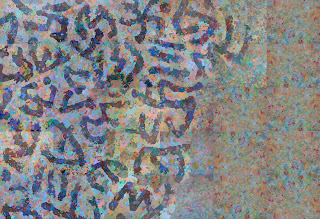
Late April 2008
Peter K asks whether I’ve found a title yet, having noted my reticence about that problem lately. Well, almost, I think, as the work itself moves quietly on. Strangely enough while this picture stands in need of a title I spent most of last Sunday at the Bloomsbury postcard fair with a title that is in search of a picture.
In the vein of the exhibition We Are The People, where I showed a sample of my embarrassingly large collection of old photographic postcards, I have one card which shows two anonymous boys with their teddy bears, which I want to use for half an evenhanded diptych. It will be entitled ‘Our teddies are called Mahomet and Ali. They are always fighting’. This refers of course to the glum affair in Sudan where a teacher was imprisoned for allowing her pupils to call a teddy bear Muhammed, the world’s most common first name.
The other half of the diptych calls for a postcard image of a similarly anonymous girl holding a golliwog, the title of which will be ‘My golliwog’s called Jesus’.
I did in fact find one card that may be right. In case a better turns up I’ll wait to put it up until the next entry at which time I will also divulge the title of my painting, on which multiple cliffhanger…
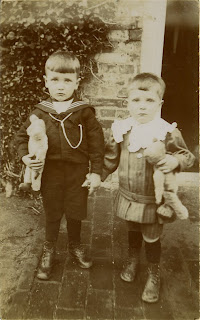
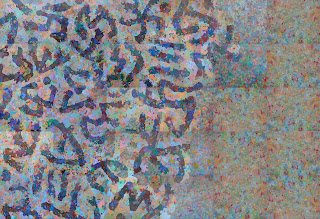
Mid April 2008>
How predictable is the unpredictability of art and the artist....
No sooner had I vowed to move forward, leaving unresolved areas to the end, than I was scuttling back to the middle South of the painting, to the chief disaster area where a calligraphic motif has been quietly strangling itself for weeks; an event that was robbing the work of much of its rhythm.
An interim operation brought immediate relief, though this kind of surgery is difficult since a new tracery has to be teased out of the old in negative fashion. Scraping back to the underpainting seems not to be allowed: I don't know where such constraints come from or why I declare myself not free to use any strategy I fancy. It is yet another aspect of the picture's tendency to dictate terms and my own tendency to accede to its wisdom. Perhaps the painting is protecting its own integrity of surface, an imperative in art from Cimabue to Jackson Pollock and beyond.
Also it needs to guard its nature as a composition, which is that of a continuum. Apart from the early radical gesture of replacing the North East corner panel, all procedures have been additive. The rightness of this current emendation was proved by how, once the incision was complete, the separated section floated free; like a released balloon.
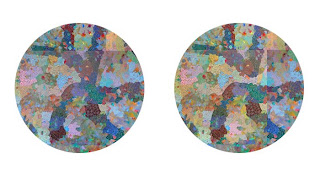
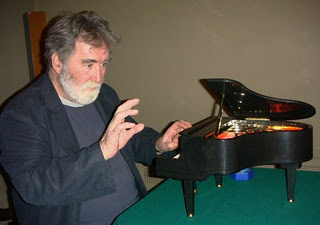
The second Architecture and Music forum on Monday 21st April at the Royal Academy explores performance, silence and space. The forum, which has already sold out, will feature a performance by Tom Phillips of John Cage’s 4’ 33”, and a discussion with electronic musician, music theorist and record producer, Brian Enoand architect and musician Vesna Petresin Robert. The event will be chaired by Robin Rimbaud aka Scanner.
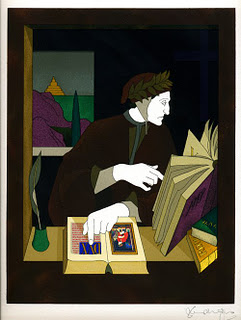
A new exhibition about the art of the book opens at the Victoria and Albert Museum today. Blood on Paper, which features work by Tom Phillips, aims to show the extraordinary ways in which the book has been treated by leading artists of today and the recent past. Blood on Paper will focus on new and contemporary work, and on books where the artist has been the driving force in conception and design. Admission is free and the exhibition runs until June 29th 2008. Illustrated here is Dante in his Study from Phillips's version of Dante's Inferno.
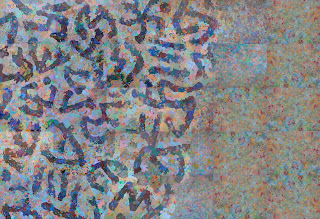
as at April 8th 2008
I begin to suspect as I forge on eastwards that I leave too many worries in my wake; a mounting toll of passages which do not quite work. Some I will no doubt be able to nudge into life while, with others, I can lean on my favourite Zen mantra, These problems will tend to disappear. There are however one or two trouble spots that, in that fine imagined last westward sweep of revision and adjustment, might continue to prove intractable: yet my instinct (which may well be cowardice in disguise) tells me to move on.
Every picture has its puzzle-solving crises and needs, at some juncture, either a small but daring manoeuvre or a grand gesture (eg turning the whole thing upside down). To proceed unchallenged is as unsatisfying as beating a weak opponent at chess, or breezing through a Sudoku in merely the time it takes to fill the squares.
A good Sudoku however, will usually bring one to a point of exasperation, after which miniature agony one suddenly spots the critical move and all remaining numbers tumble into place. So with the picture I trust to the late intervention of the Fairy Feller’s Master-Stroke to crack the problem.
It is not irrelevant to invoke Richard Dadd since this painting too has its lunatic aspect. Its dogged intricacy has much in common with the art of the mad, as Harry Birtwistle (himself only just released from the million-note labyrinth of a new opera) was quick to remark last week when he came to take a look at the picture.
In art you have a chance to repair the past so it’s forward ahead for the harmless artist self-sectioned in his studio and clinging to the words of William Blake… If a fool would persist in his folly he will become wise.
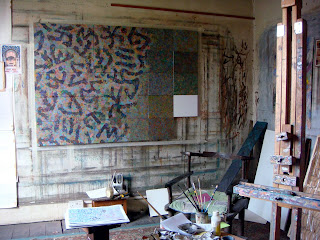
Early April
To get oneself talking, ask oneself a question. One reason for laying down the splodgy field of random colour is to have something to respond to other than the frightening white of a newly primed panel [see the unworked panel here in the southeast of the painting ].
Even as a child my first instinct was to mess up the paper before beginning, hoping to find in that mindless confusion of runny posterpaint some suggestion of event. Although I did not know it at the time this is Leonardo's recommended method for the young artist whom he instructs to gaze at a stain on the wall until landscapes emerge and are peopled with figures.
With my painting, by perverse extension, I set up one abstraction to feed another.
In addition to banishing the virginal white [the only time any picture is perfect] I thus drive away the fear of finding no colour in my head.
For I am not one of nature's born colourists. Just as at art school there will always be, amongst one's fellow students, one that cannot make an awkward or ugly mark there will be another who is tone perfect… I can see her now… she has put down a vibrant crimson and is mixing some kind of twilight blue… and yes, it nestles against the red. Each makes the other sing… and now a yellow green satisfyingly completes the chord.
Such harmonic certainty one can but envy and congratulate, and then pass on to find one's own mode of plundering colour's endless resource. The same has been the story in my musical life where I have struggled to attain even a modestly reliable sense of relative pitch.
It was through music in the early sixties that I found release. John Tilbury was my mentor and through him I became friends also with Cornelius Cardew, Christian Wolff and most especially with Morton Feldman. I learned to value every and any combination of notes and timbres. So, by analogy, I saw that there were no colours that did not go together. Each conjunction has a character and reverberative identity to be sought and used. To free myself further from the Euston Road I also used chance (via the I Ching via John Cage) to trap myself into making bolder decisions.
I found my motto in the usual place – the inexhaustible pages of A Human Document.
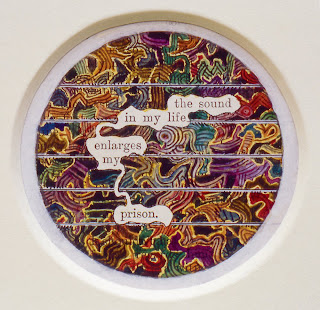
The process of mining such fragments from Mallock's text, I suddenly realise, is the mirror image of making this picture; working over the colour field, selecting parts of it and using the shapes that eventuate. With A Humument I am of course, by mining his field of verbal colour, standing on someone else's shoulders, whereas here in the painting (despite the anatomical difficulty) I am standing on my own.
In music one plays best by listening, even just to oneself. When I'm improvising at the piano (the only kind of playing I do these days) it is by hearing some shift in the bass that I am made to divert the right hand from what it was poised to play and reach for something more inventive. I am not much of a pianist so I need my own self to give me all the help I can get, and then not to be afraid to take it.
Slowly one makes progress. I used to be scared of yellow which I never seemed to be able to control. Now I've learned to let it have its way. I have, however, yet to learn to use black confidently as a colour.
Perhaps not being a natural colourist has had its advantages since I've been forced into discoveries by treating all colours alike: it is a version of democracy.

Three pages from A Humument appear in a group exhibition, Romance, which runs until June 6th at the Kowalsky Gallery at DACS. The gallery is open Monday to Friday between 10am and 5pm by appointment and as part of the Time Out First Thursdays initiative will open until 9pm on Thursday 1st May and Thursday 4th June. For more information visit the Kowalsky Gallery website
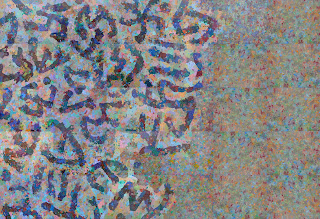
Colour Notes I
An inventory of the names on the labels on all the tubes that so far have been squeezed in the service of this picture would read as majestically as Homer’s epic list of ships. You might from that expect the colour orchestration of the work to be as lavish as in the tone poems of Richard Strauss (with the risk of being as lurid as in those of Respighi) and yet the painting on the wall of my studio seen at any distance is in most lights, a relatively sober affair.
Any detail however, will show the variety of pigments present and the relative purity of their mixtures (e.g. almost no use of black with any of the colours).
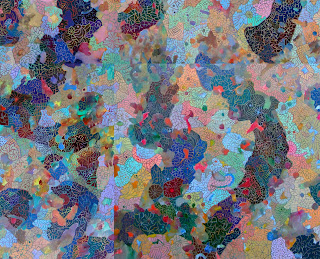
As is so often the case in art some larger thing than the actual passages and sections that one is concentrating on will eventually dominate the painting’s character. This overall identity might run counter to any plan and be wholly beyond the artist’s powers of prediction. Similar subverting of intentions is the process after all that gives us for example such oxymoronic emblems as the melancholy clown.
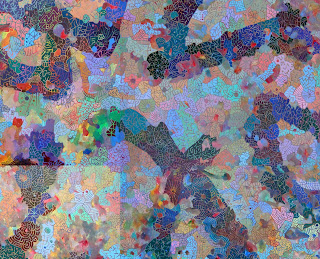
Of all the art forms painting is the most like alchemy. It has much in common with that other unsinister alchemical craft, cookery. Who could predict for example that a mixture of potato leftovers and yesterday's gone-cold greens, when mixed and fried up, would produce that magical and uniquely flavoured dish we call bubble and squeak?
An artist’s manual, with its many recipes for grounds and glazes, its guide to the use of arcane implements and its roster of recommended procedures (e.g. “start lean end fat” meaning don’t use too much oil in the underpainting) is very much like a cookery book. Completely to ignore the precepts of handbooks can lead to disaster as with Leonardo’s self-destructing medium for mural painting or Reynolds’s fatal use of bitumen; yet every chef would understand Picasso’s dictum “If I can’t find the red I use green”. They would also be quick to see the truth in Frank Auerbach’s reply to criticism of the dangerous looking thickness of his paint, “What counts is whether you put it on with love”. Give two cooks the same book and they will come up with different results. As with painting, when garniture serves substance and all is unified, spice against spice, the final dish transcends the recipe.
Here in my own picture, partly through ignorance and partly through the invitation of chance, I find myself producing a thing of unexpected mutability. At differing times of day the colour field presented can range from an aura of mossy green to a slightly baleful purple. In the early morning it may have a blue cast (reminding me of old Westerns shot in Eastmancolor), whereas when seen by electric light alone all the acid fire of reds and yellows awake as if from a sleep to illuminate a quite other kind of battlefield.
Every picture of course is changed in some degree by varying light but none (at least of mine) has ever surprised me with such a range of moods.
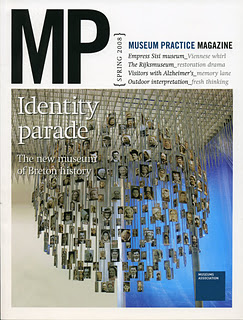
The current issue of Museum Practice Magazine, Spring 2008, profiles Tom Phillips as artist, curator, museum trustee and collector.
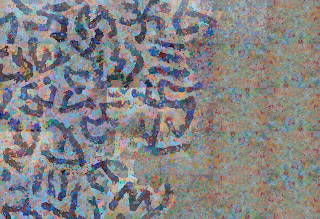
Over a print-out of the picture in its current state (as seen above) I make another drawing. It shows how I am gamely trying to control the present while predicting the future and tinkering with the past. Such diagrams of shifting thought rapidly become palimpsests, as from a pictorial Satnav unreliably installed, of pathways rejected almost as soon as they are proposed.
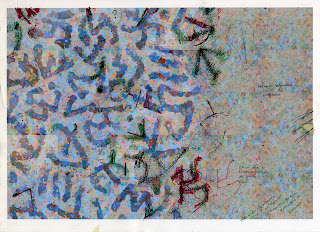
The encounter I recently described, where paranormal planes of colour rise disembodied out above the picture’s surface until the whole work seemed to be made of shimmering veils, now seems less disconcerting. Finding that the phenomenon is not unique to this painting has helped. I discovered that a picture I have been working on in my Oxford studio produces the same sensation. It only needed a short stare to make this canvas in its turn yield up similar hovering illusions of depth. This picture, also long worked on and as yet untitled, is painted in the manner of a mosaic. In a sense it is a study for the work I am doing in Westminster Cathedral. The insistent patterning of the tesserae engenders in this case its own layer of black, a spidery phantom which floats well free of all other colours, as if to illustrate Dr Johnson’s wittily abstract definition, in his great dictionary, of a net... ‘anything reticulated or decussated at regular intervals with interstices between the intersections.’
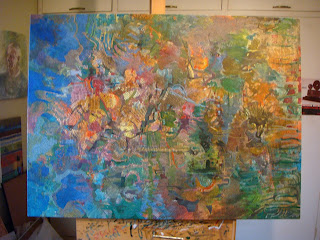
Mosaic Painting, in progress, 2008.
Archives
- 2023
- June (2)
- May (1)
- 2022
- October (1)
- September (1)
- July (1)
- June (1)
- 2021
- September (1)
- July (1)
- May (2)
- April (1)
- March (1)
- 2020
- December (1)
